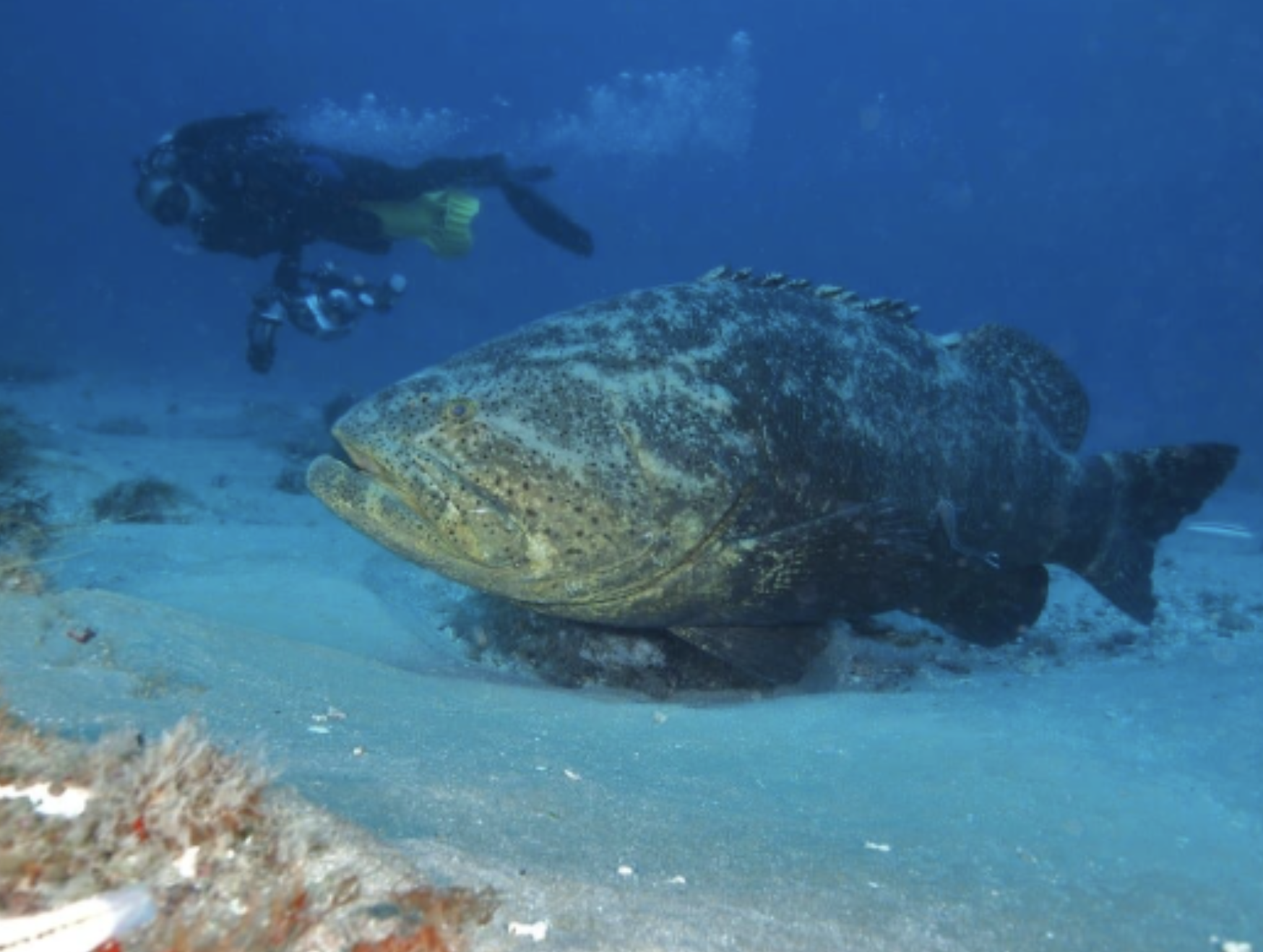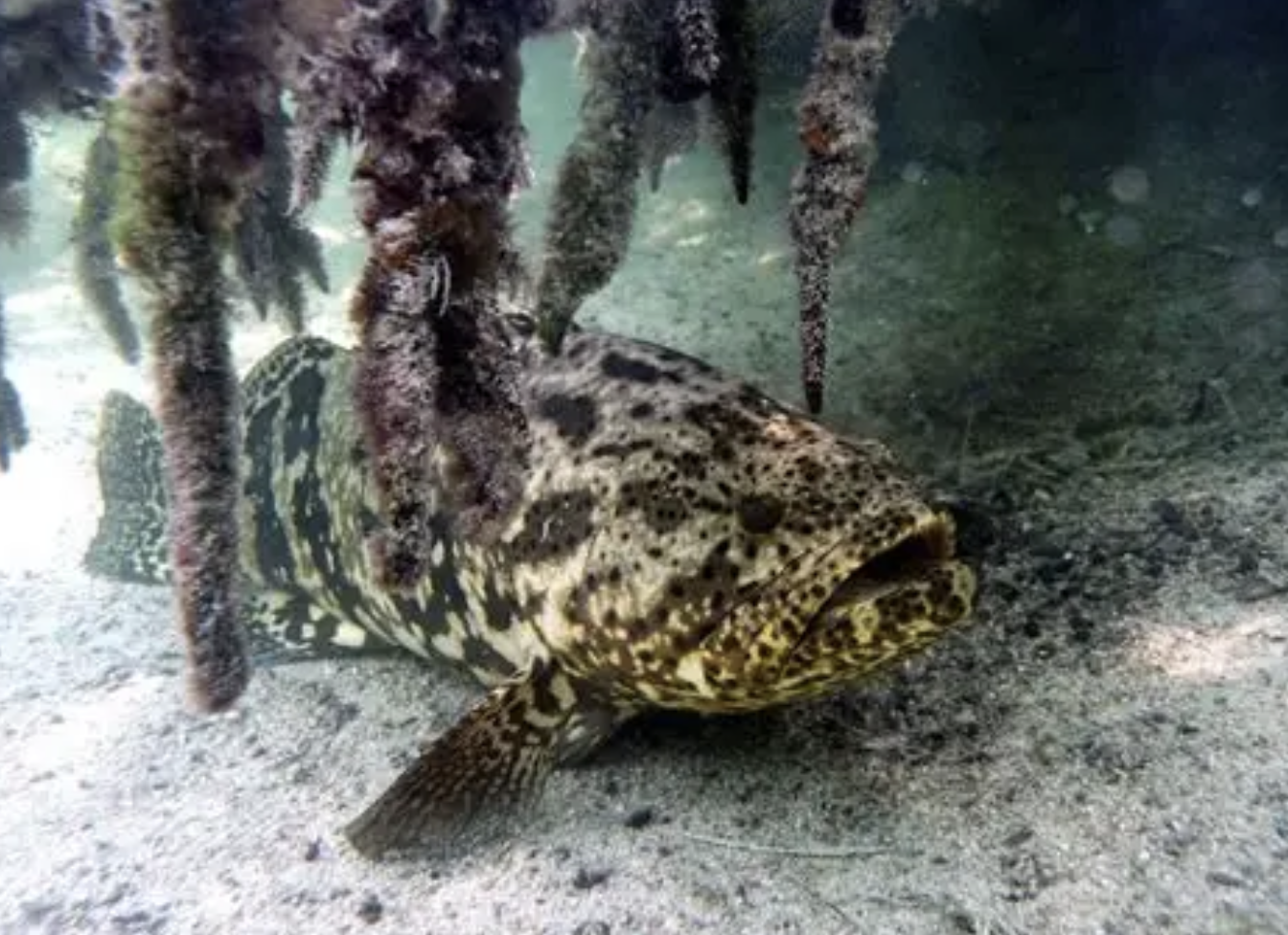Creature Feature: The Goliath Grouper (Epinephelus itajara) of Tampa Bay.
By: Renny Moulton
Goliath grouper (also called jewfish) are typically found in the subtropical and tropical waters of the Atlantic Ocean and along the coastlines of the Gulf of Mexico, making Tampa Bay one of their primary homes. They prefer to live in shallow tropical waters around coral and artificial reefs, where they can thrive. As a result, many of the large bridges, piers, water overhangs, and shipwrecks found along Florida’s Gulf Coast, like the Skyway Bridge, serve as primary habitats for them. Goliath grouper are the largest species of grouper in the Atlantic Ocean, as they can grow up to 800 pounds, 8 feet in length, and can even live up to 37 years. Their appearance consists of black or yellow mottling patterns (sometimes appearing greenish), with black spots along both their head and fins. They also have small eyes, a rounded tail, and five black stripes that are often more noticeable in juvenile goliaths. They have large jaws and mouths that allow them to eat large amounts of prey, aligning with their opportunistic feeding behavior, where they typically ambush slower-moving bottom-dwelling prey. They do this by rapidly expanding and closing their massive mouths, swallowing prey whole. Surprisingly, one common prey of Goliath Groupers is Calico crabs rather than a species of fish.
At a young age, juvenile goliath groupers can be found in mangrove and estuary habitats, which serve as nurseries for them. After 5-6 years, Goliaths grow in size and become mature, becoming less susceptible to predators like king mackerel, barracuda, and moray eels. They will then move out of shallow water habitats into deeper but shallow artificial or coral reefs offshore, where their only natural predators are large sharks. When it comes to the reproduction of goliath grouper, they are protogynous hermaphrodites, meaning that they start as females and become males later, a process that can be advantageous for reproduction. Males will mature at 5 to 6 years of age, reaching around 36 inches in length, while females will first mature after 6 to 7 years of age, reaching 45 to 53 inches in length. When spawning, goliaths will typically be found in groups of one hundred or more around structures like piers and bridges during the summer and fall months, such as July, August, and September. While not spawning and feeding, groupers are relatively solitary, staying in the same place with minimal migration, becoming territorial for the structures they settle in.
Historical Threats
In the past, Goliath Grouper were heavily pressured in the 1970s to 1980s by commercial fishing due to their size, their behavior to group up, catchability (easy to find and hook), and meat quality for human consumption. They nearly went extinct in 1990, so a moratorium was created, closing the season and banning their harvest. Since the moratorium, their populations and the size of the groupers themselves have expanded, possibly becoming more abundant than they were before the ban in 1990. Despite how much better their populations are doing now, it is still important to consider how they remain susceptible to fishing pressure due to a multitude of factors. As previously discussed, one factor is their tendency to gather in large numbers, which makes them very susceptible to fishing pressure sinceindividuals can predict their locations during their known spawning cycles. Along with this, the loss of juvenile habitats such as mangroves and shallow water estuaries in relation to climate change makes them even more susceptible to fishing. A final factor that makes them susceptible to spawning pressure is their long lifespan, which allows fishermen to target groups in certain areas over an extended period. Outside of fishing pressure, they are also threatened by environmental stressors such as red tide algae blooms and cold fronts. Even though the harvesting of Goliath grouper in the past diminished their population to the point where they were near extinct, a harvest program was created for them on March 3rd of 2022, allowing specific individuals to keep one goliath per season at a set size
Conservation Efforts
Many different conservation efforts have been made to help protect these magnificent Goliath Groupers. Firstly, the Florida Fish and Wildlife Conservation Commission has created numerous guidelines for the catch and release of Goliath Grouper to ensure that if people do catch them, they are correctly handled and released. For example, these guidelines emphasize that individuals should handle juvenile grouper with care and release them alive promptly. In contrast, larger groupers must be kept in the water because their skeletal structure cannot support their weight out of the water, which could potentially damage the fish. While smaller ones can be taken out of the water, it is still recommended that they are kept in the water when being unhooked. Suppose grouper are caught in deeper water and experience barotrauma (when their air bladder expands, preventing them from properly regulating their buoyancy in the water). In that case, FWC suggests using a deceding device or venting tool to bring them back to the bottom. All of these guidelines help conserve and protect these groupers, highlighting the critical role educators like FWC and Tampa Bay Watch play in safeguarding and teaching people about these species. Outside of these guidelines, the harvest program helps conserve these species by allowing people to catch and eat them sustainably, at a rate that supports goliath grouper populations. Within the harvest program, permits (divided into two categories) allow individuals to keep one goliath grouper per season, which must be between 24 and 32 inches in total length, and are distributed through a lottery system. If individuals obtain a permit, they are given a tag that must be used on the Goliath grouper they harvest, along with different fishing guidelines for specific gear and locations. In conclusion, we need to focus on the conservation of these animals because they are easily susceptible to damage, as evidenced by their near extinction in the past.
References:
Fish and Wildlife Conservation Commission. (n.d.). Goliath Grouper. Florida Fish and Wildlife Conservation Commission. Retrieved October 15, 2025, from https://myfwc.com/fishing/saltwater/recreational/goliath/ FWC
Tampa Fishing. (n.d.). Goliath Grouper Fishing. TampaFishing.com. Retrieved October 15, 2025, from https://www.tampafishing.com/goliath-grouper-fishing/ Tampa Fishing
National Oceanic and Atmospheric Administration. (n.d.). Atlantic Goliath Grouper – Overview.NOAA Fisheries. Retrieved October 15, 2025, fromhttps://www.fisheries.noaa.gov/species/atlantic-goliath-grouper/overview


